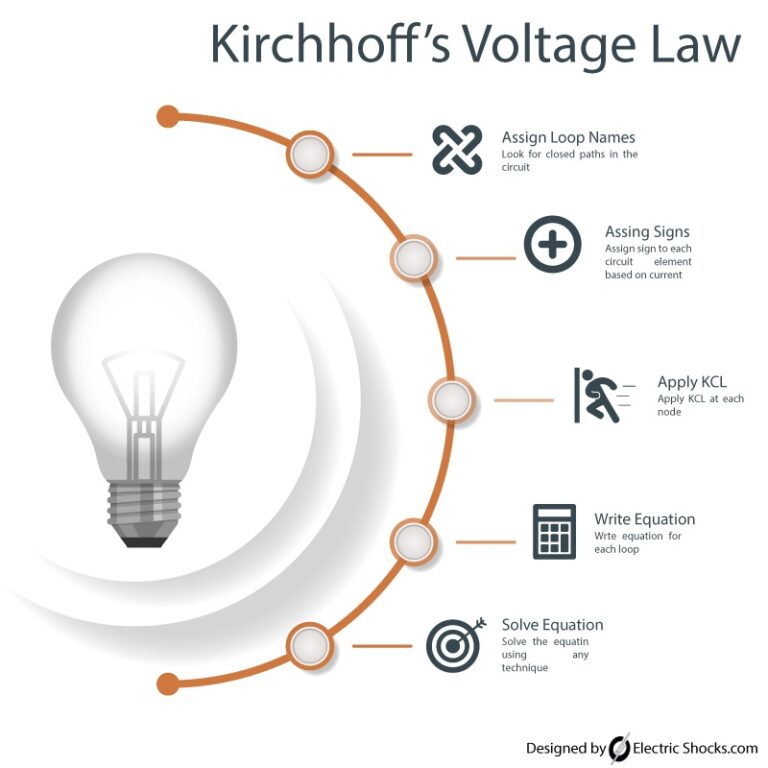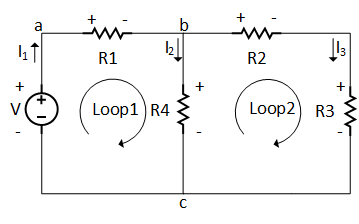Learn what is Kirchhoff’s voltage law and how to apply it with examples. Kirchhoff’s voltage law KVL or Kirchhoff’s second law deals with the conservation of energy in a closed-loop electric circuit. The KVL is the fundamental law for electrical circuit analysis.
What does Kirchhoff’s Voltage law state?
The Kirchhoff Voltage Law KVL states that the algebraic sum of voltage produced and the voltage dropped in a closed loop (a closed path) of an electric circuit is always equal.
- Top 5 Essential Electrical Wiring Rules to Follow for Your Home
- Elevate Your Boating Experience with a Marine SoundBar
Mathematically,
$\sum{V_{Rise}} = \sum{V_{Drop}}$
In other words, the energy is conserved across a closed loop of an electric circuit.
Note that the algebraic sum means taking into account the polarities and signs of voltage sources and voltage drops. When applying the KVL to any circuit, all the signs (+ -) or (- +) must be taken into account correctly otherwise the calculation will be wrong.
- Differences Between Fixed Wiring Testing and PAT Testing
- Sustainability in Flex: Green Practices in Flexible PCB Manufacturing
Gustav Kirchhoff a German physicist, presented two laws; Kirchhoff’s Current Law (KCL) and Kirchhoff’s Voltage Law (KVL). Ohm’s law is very basic, which may not be sufficient to analyze a complex circuit. Kirchhoff’s Voltage Law KVL provides the basis for Mesh Current Analysis.
How to apply Kirchhoff’s Voltage Law
Identify Close loops
Identify closed loops in an electric circuit and assign the loop name to each closed loop. Suppose a loop current in a certain direction.
Identify current direction
Now, caption each circuit element with a polarity sign as following the supposed current direction.
Apply KCL
Apply Kirchhoff’s Current Law KCL at each node and write current equations for each node.
Write KVL equation
Now apply KVL at each closed loop and write the equation for each loop. All the voltage produced should be equal to all the voltage drops.
Combine equations
Now substitute the KCL equations in KVL equations to get the final equations. Solve those equations using any of the solvers.

Kirchhoff’s Voltage Law Example
Suppose a circuit with two parallel paths (loops) and a single voltage source (DC), as shown in the diagram below. Find the current and voltage of each element of the circuit for the following given circuit parameter using Kirchhoff’s voltage law.
R1 = 5Ω
R2 = 10Ω
R3 = 5Ω
R4 = 10Ω
V = 20Volts

- Elevate Your Boating Experience with a Marine SoundBar
- Efficient Travel Refrigerator for Cars: A Complete Guide
KVL Solution:
Assign Loops Name:
There are two loops (closed paths) in the circuit, loop 1 with two resistors and a single voltage source, whereas in loop 2 there is no voltage source, three resistors only.
Assign Sign to Circuit Elements:
Now, assign a positive sign to the resistor terminal which is closer to the voltage source positive terminal, and a negative sign to those that are closer to the negative terminals. OR you may assign a (+ -) sign to each component terminal by going through the loop. But make sure that the sign of voltage rise (- +) is exactly opposite to the sign of voltage drop (+ -). Both will give you the same results, even the same equations.
Assign Current Names:
Assign a name to the current of each loop and as discussed in KCL, write equations for the current at each node. For the above circuit KCL equations will be:
at node a: $I_{1}= I_{1}$
at node b: $I_{1}= I_{2 }+ I_{3}$
at node c: $ I_{2 }+ I_{3}= I_{1}$
Write Loop Equations:
The next step is to write equations for each loop. Based on the sign and current name assigned, as shown below.
For loop1: $V =I_{1}R_{1}+ I_{2}R_{4}$
For loop2: $0 =I_{3}R_{2}+ I_{3}R_{3}- I_{2}R_{4}$
Notice the negative sign in the second equation, it is because of being opposite in the direction of the loop arrow i.e. for R2 and R3 it is (+ -) but for R4 it is (- +).
Now, put the value of I1, which will give you two simultaneous equations with unknown variables I2 and I3. The value of these currents can easily be out using Cramer’s rule for the matrix.
$V =(R_{1}+R_{4})I_{2}+ R_{1}I_{3}$
$0 = – R_{4}I_{2}+(R_{3}+ R_{2)}I_{3}$
Let’s put the values of resistors and the voltage source, and see what happens
$20=(5+10)I_{2} +5 I_{3} —-(1)$
$0= -10I_{2}+(5+10)I_{3} —–(2)$
Now multiply the equation (1) by -3 and add with the equation (2)
$0= -10I_{2}+(15)I_{3} —-(2)$
$-60= -45I_{2}-15I_{3} —-(1)$
- 4 Tips for Buying Industrial Equipment for Your Business
- 7 Safety Precautions to Take When Doing Electrical Repair at Home
Solve The Equations:
Adding the above two equation will give us the equation (3)
$-60= -55 I_{2}+0 -(3)$
OR
$I_{2}= -\frac{60}{-55}=1.09 Amp$
Now putting the current I$_{2}$ in the equation (2) to get current I$_{3}$
$0= -10(1.09)+15I_{3}$
OR
$I_{3}=10\frac{(1.09)}{15}=0.72 Amp$
By applying KCL to the node b, the following equation can be obtained
$I_{1}=I_{2}+I_{3}$
Now putting the values of the current will give us the value of I$_{1}$
$I_{1}=1.09+0.72=1.81 Amp$
Now, it is easy to find any parameter of the circuit, just use the ohm’s law, as shown below
$V_{3}=I_{3}R_{3}=0.72(5)=3.6 Volts$
And
$V_{2}=I_{3}R_{2}=0.72 (10)=7.2 Volts$
$V_{4}=I_{2}R_{4}=1.09 (10)=10.9 Volts$
$V_{1}=I_{1}R_{1}=1.81 (5)=9.05 Volts$
Does Kirchhoff’s voltage law apply to parallel circuits?
Yes, KVL law applies to the parallel circuit. First, identify the loops and apply the KVL. The circuit in the above example is a parallel circuit.
Kirchhoff’s Voltage Law Limitation:
The KVL has some practical limitations besides it is a very useful tool for circuit analysis.
- In the high-frequency circuit, the fluctuating magnetic field can link the circuit, which contradicts the assumption of KVL.
Short Answer Questions:
Can Kirchhoff’s voltage law be applied to an incomplete loop?
Kirchoff’s second law must be that the loop is closed. The open loop will not allow the current to flow and there will be no voltage drop across the circuit elements. All the voltage in the loop will appear across the open portion.
What is a parallel circuit?
A parallel circuit is an electrical arrangement where components are connected side by side, allowing multiple paths for current flow. Voltage across components remains constant, while current divides among them.
Does Kirchhoff’s voltage law apply to parallel circuits?
Yes, Kirchhoff’s Voltage Law applies to parallel circuits. It states that the sum of the voltages across all components in any closed loop within the circuit is zero.